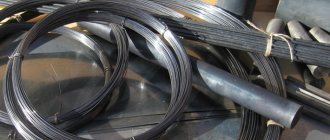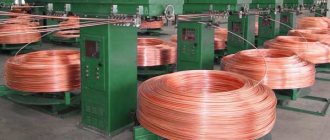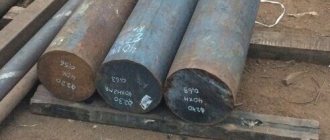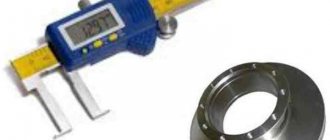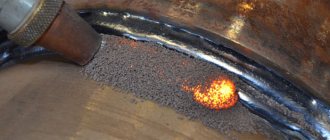Main types
There are two main types of barbed wire. Let's take a closer look at them.
Galvanized
Despite all the external similarities, modern barbed wire is not exactly the same as what was patented at the end of the 19th century. To date, about 450 patents have already been issued for it. Collectors of wire fences (it turns out there are such people) count up to 2 thousand different types and samples. Manufacturers' catalogs often mention only 2 dozen main varieties. The simplest option is a single-base corrugated design with spikes throughout.
The thickness of such a product is most often 2.8 mm. This is the option that is usually used in summer cottages and fences around private houses.
Reinforced
Coating with a protective layer of zinc does not always help solve the problems. Sometimes more significant strengthening of the enclosing structure is required. The following options are known:
- Bruno spiral (coils of different diameters);
- flat corrugated tape with a pointed edge;
- “chain-link” with diamond-shaped cells;
- spikes that complement the main fence.
A biaxial (more precisely, two-basic) barbed barrier is also in demand. For the most part, it is made of galvanized metal.
A typical barbed wire texture looks like this.
Products operating under voltage must be designed for a current of 2-10 kV. They are mainly produced for livestock farming and penitentiary use. Returning to tape structures, it is worth pointing out that they can damage significant areas of soft tissue. They are used to protect structures, including those built on frames and supports. And the classic type of barbed wire is used mainly in independent execution.
The traditional version is often called “thread”. This is always galvanized material with a thickness of 2.5 to 2.8 mm. Exceeding these limits is strictly not recommended. There are threads made from one wire or from two strands, braided into a “pigtail”. The same distinction is made between spikes. Stamped spikes are used mainly where the maximum degree of security is needed.
The elastic “thread” is relatively strong and has a small cross-section. This material is more resistant to the negative effects of temperature changes. Resistance to mechanical stress is also increased. As a result, “threads” with increased elasticity are used for the construction of large spans. As for the “soft” wire, it is much more convenient when fastening.
However, over time, such a fence weakens and begins to sag intensively. This drawback is especially pronounced with significant spans. The problem is not too significant if you install the wire in small areas. In addition, technologists classify piercing and cutting tape and reinforced “twist” into a special category. Experts consider everything else to be only subspecies of the three main types of barbed wire.
Installation rules
Vertical supports dug into the ground are fastened in increments of no more than 3 m. These supports are quite sufficient for installing the wire itself; nothing else is required. But increasing the degree of security is only possible with additional tension on the wire in the transverse plane relative to the main strip. Barbed thread can be used in addition to already created protective structures. In this case, it is mounted on top of fences and gates.
Reinforced tape is much more difficult to install. To install it you will need:
- scissors for cutting metal reinforcement;
- Grinder;
- some other tools, which depends on the method of fastening the wire at the support points.
Installation of Egoza wire will be simplified when using special brackets. For flat and spiral models, you can use the same type of brackets. They can be installed in a variety of places. Now they sell brackets in different formats:
- direct;
- L-shaped;
- Y-shaped.
You should prepare the fence yourself with a step between brackets of no more than 2.5-3 m. You need to work not only in protective gloves, but also in thick clothing. Sometimes it makes sense to even wear safety glasses. The shape of the bracket is selected taking into account ease of installation. Before starting work, the area should be marked.
The reference points are fixed using bolts or welding. Then a spiral is mounted on top of the brackets using special brackets. The next step is to stretch the double string along the entire length of the spiral. The spiral itself is aligned, and it is secured using twists of a special pattern.
Finally, the individual parts of the wire fencing are connected using mounting brackets. If the fence is energized, you must warn about this by hanging special signs around the perimeter with clear warning text.
Watch the video below about the production of barbed wire.
Advantages of barbed wire fences
The history of using barbed wire to fence the territory of various institutions goes back more than one century. Spiked products were strung around pastures and private lands to prevent anyone from entering from the outside. In security zones, the thorn protected against attempts to escape.
The installation procedure depends on the required level of protection
Currently, barbed wire is widely used, the installation of which has advantages over other methods of increasing the degree of inaccessibility of the fence:
- quickly installed;
- impossible to overcome;
- cheap;
- installed on an existing fence;
- transparent;
- has a terrifying appearance;
- capable of seriously injuring;
- Corrosion resistant.
The thorn looks less aesthetically pleasing than forged peaks, but it is impossible to overcome the fence even with the help of wire cutters and other tools.
V-bracket placement diagram
History of creation
It is impossible to name just one name of the person who invented the barbed defense. But it is quite obvious that the weak restraining ability of ordinary flat wire prompted its creation. It can hardly be considered as a serious barrier for animals on pastures or for criminals in prisons. In 1872, the American farmer G. Rose came up with the idea of attaching boards with sharpened wires to a simple wire fence. The patent was received approximately six months later.
But the modern look of barbed wire was created by Joseph Glidden. He realized that attaching sharp elements to boards was irrational, so he created a metal structure, which without additional devices became a serious obstacle. Wrapping them with metal wire without points helped prevent the spikes from moving.
Important: Glidden did not create his design from scratch, but was based on samples already known at that time, including those proposed in France
Barbed wire also owes a lot to J. Gates. For the first time in the United States, he widely used advanced metal smelting methods, which made it possible to reduce production costs. It was also Gates who carried out an advertising campaign showing that dozens of cows were securely held by a wire fence. Reducing the price of the finished product and bright marketing did their job - soon the “thorn” was bought not only by those who were looking for an effective replacement for a wooden fence around their home. They began to use it in places where the abundance of forests made it possible to build traditional pens, because it turned out to be simpler and more profitable.
Types and applications of steel wire
As you can see, depending on the production method, the use of protective coating, as well as thickness, weight and density, different types of steel wire are produced.
When we talked about the manufacturing process, we mentioned that the finished product is fired. In this case, the output is a flexible product that can be used for knitting, for example, chain-link mesh, bending reinforcement, supports for trees or plants, and so on.
Such wire is usually galvanized due to the nature of its operation - outdoors, with frequent direct exposure to water, high and low temperatures.
- For Chainlink, heat-treated, zinc-coated wire with a diameter of 1.30 to 6.30 mm is used.
- For grape supports, flexible low-carbon steel wire with a rather small nominal cross-section is also used - 2.10-2.30 mm.
- For communication lines, only galvanized steel wire must be used, while the core itself is made of special “T” type steel.
Therefore, both thin and thick wire products are widely used. For some types of fittings it is also important to use rigid, unburnt wire.
And, in conclusion, we can say that we have proven what was said at the beginning: low-carbon steel wire is a truly universal material that is widely used to make completely different products that find their application in many areas of life.
Photo of barbed wire
Vaira Metal mesh Wire Fences and Fidget
- Rabitz
- Lightweight Cossack mesh
- Uzelfix mesh
- Welded mesh
- Masonry mesh for reinforcement from wire VR-1 (armopoyas)
- Cossack masonry mesh
- Expanded mesh
- Woven mesh GOST 3826-82
- Corrugated mesh
- Channeled mesh
- Twisted hexagonal mesh
- Stainless filter mesh
- Brass mesh L-80
- Conveyor woven mesh
- Conveyor woven mesh
- Hinged mesh
- Reinforcing façade fiberglass mesh
- Tensioner for mesh and wire
- Low carbon wire GOST 3282-74
- Egoza
- Metal fences
- Construction nails
- Perforated sheet
- Gabions
Steel fiber
- Lawn mesh
News
Installation of the “thorn”
To protect your dacha, there are 2 options for installing a protective fence:
- On top of or on a regular fence;
- Make a continuous spiked (barbed) fence.
For this we need:
- Barbed wire (preferably reinforced);
- Mounting brackets;
- Electric welding machine;
- Electrodes;
- Hardware (staples);
- Pliers;
- String;
- Protective clothing;
- Mittens.
The brackets are welded to the posts. The barbed wire is stretched and secured with hardware. To prevent it from sagging, the string is stretched. A “thorn” is evenly distributed and secured on top of it.
To make a continuous fence made of barbed wire (which can often be seen in the photo), pillars are dug in at a distance of at least 2 meters from each other. To increase stability, it is better to concrete them or make supports.
To tighten and fix the “thorns”, “eyes” are welded to the posts along the entire length. Their pitch is at least 100 mm. The barbed wire is secured to the “eyes” using hardware (staples).
To increase the protective functions of the fence, voltage can be applied to it. At the same time, you must remember to post a sign warning about this!
Fencing
You can install barbed wire on:
- Pillars. It is enough to secure them well, stretch a “thorn” of a suitable type between them;
- An ordinary fence (fence). It is installed on top, mounted on special brackets (gitter mesh). Usually such a fence is made of stone, quite massive and high, and the barbed wire itself is laid in the form of a spiral.
Varieties
According to the manufacturing method, the “thorn” is divided into:
Galvanized steel wire with spikes along its entire length. Its thickness is 2.8 mm. It is the simplest protective structure for protecting your property on a farm or country house;
Reinforced (corrugated) tape. It looks like a thin strip of steel with razor-sharp edges. It has 2 varieties - AKL (straight) and ASKL (twisted).
Domestic manufacturers produce various versions of the “thorn” for all household, industrial, strategic and other needs. The most popular and well-known products are under two brands:
- "Egoza";
- "Gyurza."
Design features, application
A thin strip (metal thread) with spikes along its entire length - this is the design of barbed wire. Simple and unpretentious. But very effective!
France is considered the birthplace of the “thorn”, although it gained fame in America thanks to one farmer named Henry. He used it as a fence, which interested the others.
The barbed wire fence was reliable, had high protective properties at a fairly low price. This interested many farmers. There was “mad demand” for such fencing.
The first company that seriously began selling “thorns” was able to sell 270 tons of them!
A lot of time has passed since then. Razor fencing is still in demand and is used to protect:
- Private property (territory);
- Military bases;
- Special sports grounds;
- Strategically important objects;
- Enterprises;
- Facilities launched into construction;
- Areas where special dog training takes place;
- Various prison colonies;
- Various private pastures.
Types and scope of application
Galvanized wire products can be made from a variety of materials. A steel, aluminum, titanium base is used. In some cases, manufacturers give preference to nickel, zinc, and copper. Suitable alloys are bimetallic or polymetallic.
Thanks to this, the wire has improved qualities and excellent corrosion resistance. It is sold to customers in special skeins of 20-200 kg. Coils of 0.8-1.2 tons are also used.
Galvanized wire is produced using thermal treatment technology or without the use of this method.
The methods of processing the material also differ - soft knitting treatment, thermal or hard treatment without treatment.
If the wire is subjected to thermal hardware action, then it can be used in the manufacture of nails with a diameter of 1-6 mm, chain-link mesh, and in the process of aerial cable fastening. Taking these factors into account, the price of galvanized wire is determined.
The semi-finished product is used in the production of household items - handles for buckets, hangers for hanging clothes, fasteners for drawers.
Sometimes the scope of application expands, and therefore it can be found in the process of reinforcing preparation of power transmission wires. It is used not only for installing cable products, but also for creating staples, key rings, and paper clips.
The material is used in the manufacture of mesh, and also as an element of security systems; in particular, galvanized barbed wire is popular.
There are several other areas of application:
- In welding works.
- For laying communication channels - it has normalized electrical resistance and low elongation. The material is type T steel. Diameter is 1.5-4 mm. The disadvantage is the risk of sagging as a result of heating. The coil of wire is covered with paper with an impermeable effect and a cloth containing chemical fibers.
- In the production of cores that are used in aluminum and steel wires without insulation. Grades for stranded and single-wire cores are used, belonging to types A, B and C, depending on the mechanical properties.
Manufacturing process
The manufacturing method depends on the type of “thorn”. For example, razor tape is produced by stamping from rolled metal sheets, steel scraps, and leftover profiles. And the “threads” are made from galvanized wire . The spines for them are made from the same material, giving the pieces a pointed shape and winding them around the base.
Most of the effort and finances are spent on the production of stranded wires. The fact is that at the initial stage they make ordinary “threads”, then twist them using a special machine. This wire is distinguished by increased protective characteristics of future fences due to enhanced technical parameters.
Peculiarities
Egoza barbed wire is a type of security fencing produced by the brand of the same name. The Chelyabinsk plant where it is produced is part of the group. Among his clients are government agencies, nuclear, thermal, electric power facilities, the Ministry of Internal Affairs and the Armed Forces of the Russian Federation. When developing wire, specialists from the Egoza perimeter fencing plant take into account the level of responsibility when protecting objects of special importance and the needs of ordinary citizens who want to ensure reliable protection of their areas.
Flat belt structures have more varied technical characteristics. Thus, for Egoza products, a spiral with a five-rivet fastening of the AKL type, the mass of the coil, depending on its diameter, ranges from 4 to 10 kg. The weight of 1 meter is easy to calculate based on the length of the skein - normally it is 15 m.
The manufacturer produces several types of Egoza brand wire. All products have common features: made from steel or galvanized tape, the presence of sharp spikes. All varieties are highly durable and reliable, have a long service life, and can be mounted either around the perimeter of existing fences or independently, supported on poles.
The main purpose of Egoza wire is to protect objects from unauthorized entry. In livestock grazing areas, it is used to prevent or stop the movement of the animal outside the designated area. In industrial, military, secret, protected facilities, in water and environmental protection zones, in places with limited access, barbed wire acts as a protective barrier, allowing it not to block visibility and access to natural light, as is the case with solid fences.
Depending on the type of product, its installation can be carried out in different ways. Most often this wire is used for:
- creating fences around the perimeter of the roofs;
- fixation on vertical posts (several levels);
- installations on supports with a horizontal tension string for 10–15 sections;
- laying on the ground (quick deployment).
All these features make barbed wire a popular solution for use on various types of objects.
In the wilds of barbed wire. Part 2
Let's continue to talk about positional defense on the Russian front of the First World War and its elements (see In the wilds of barbed wire. Part 1). Its most important element was machine guns.
Machine guns, which had such a significant quality for positional defense (compared to rifles) as accuracy of fire, were installed on the most tactically important and threatened positions (on the reverse slopes of heights and directions of probable enemy attack) and flanks (which made it possible to concentrate the crossfire of machine guns). Ideally, they tried to carry out fire coverage of the attacker.
Machine guns could be interspersed in rifle positions or installed independently (that is, separately - mainly by platoon; in this case, special machine gun trenches were built).
Machine gun company in position.
It was recommended to place machine guns in armored shelters.
The machine guns directly in the line of fire were carefully camouflaged and connected to the rear positions by means of communication.
There were 2 types of machine gun nests.
1) For constantly operating machine guns, which were supposed to not only repel enemy attacks, but also shoot at long distances at emerging individual groups of enemy soldiers and officers, scouts, etc. The operation of such machine guns was to be ensured by the presence of reinforced concrete dugouts with embrasures that allowed fire with large sectors of fire.
2) For melee machine guns, intended exclusively for repelling enemy attacks, flanking approaches to a position, etc. The nest for such a machine gun had to consist of a durable chair, allowing shooting over the parapet in different directions. Nearby there was a shelter (“fox hole”), in which the crew along with a machine gun could hide from heavy shells, and ammunition was also stored.
Bombers and mortars were ordered to be placed behind reverse slopes and terrain folds, preferably away from the trenches, and their positions were to be changed as often as possible. Bombers and mortars were located in special trenches - 50 or more steps behind the rifle positions (so as not to bring the enemy's return fire on the latter). Mortar and bomb trenches were connected by communication passages both with infantry trenches and with their own shelters.
Hand grenades were used during forays, to repel enemy scouts, to prevent the destruction of wire fences, etc.
With the beginning of the chemical war, the Russian command began to organize careful observation of the enemy’s behavior in order to detect in advance his preparation for a chemical attack. If it was possible to detect the installation of gas cylinders, artillery fire was opened on them. To provide timely warning of the start of a gas attack, special observation posts were put up in front of the positions - they notified with conditioned signals of the appearance of a gas cloud. At the signal of a chemical alarm, the soldiers put on gas masks, lit fires and prepared to repel an enemy attack.
Machine gun nests and shelters.
Plan. Instructions for fighting for fortified zones. Ed. 4., 1916. The key place was given to artillery.
Some of the available guns were placed in the battle line, and the other part was added to the general reserve. The guns in the positions were placed in special trenches, mostly located in covered positions. Heavy batteries were located at a distance of 3-5, and light batteries no further than 2 km from the front line. The batteries also had spare positions.
Rails were sometimes connected to the firing positions of heavy batteries, along which trolleys with ammunition moved.
Increased attention was paid to the issues of massing artillery fire and ensuring its concentration at the appropriate point - primarily the most important approaches to the defended position. They tried to disperse the artillery, if possible, guided by the principle: “while being apart, shoot together.”
Artillery observation posts were built to monitor the results of the fire. They could also serve as tall buildings, trees, hills.
Infantry cover was mandatory assigned to the artillery - it protected the guns and assisted the artillerymen in carrying out heavy work.
Barrage fire from artillery and machine guns was a key factor in repelling the onslaught of the advancing enemy. Improving the organization of such fire made it possible to reduce the number of fire units in a combat unit and increase reserves. Practice was based on the fact that no more than 2 minutes should pass from the moment fire was called to the opening of barrage artillery fire. Artillery densities during frontal shelling were considered optimal - no more than 100 m per battery, i.e. about 15 meters (the width of one gap) per gun. The barrage fire plan, providing for a combination of artillery and machine-gun actions, should have provided for the advancement of such fire inside the defensive zone in case the enemy broke into it. The trenches where enemy infantry had accumulated before an attack were also required to be targeted.
An external, qualifying sign of the positionality of combat operations was the presence of so-called artificial obstacles in the battle line and in front of the fortifications. Such obstacles made it difficult for the enemy infantry to advance, dismembering its battle formation, and (and this is important) - under powerful fire from the defenders. After all, even a slight delay of the advancing infantry under fire led to serious losses.
The main requirements for obstacles were maximum “invisibility” for enemy artillery observers, intractability and the ability to be covered by an effective fire system.
Combat experience has demonstrated that it is impossible to overcome obstacles along the entire front at once. It’s good if they managed to break through at several points. And it was towards these passages that the main efforts of the attacker were directed. Accordingly, the most important task of the defender was to maintain artificial obstacles - through a specially thought-out system of measures.
The strongest among the artificial obstacles were considered ditches filled with water, having a width of at least 4.2 m and a depth of 2 m. The effect increased when the ditches were reinforced with underwater wire barriers.
But the most widely used were ordinary wire fences, which had a standard width of up to 4.5 meters. Barbed wire fences became the most powerful and successful artificial obstacle in the defender’s arsenal. Which is not surprising: after all, the barriers impeded the movement of manpower - the main power of the armies of the First World War. At the same time, due to the use of wooden stakes (3 steps is the standard distance between stakes), the barriers unmasked the rifle trenches located immediately behind them (as a rule).
They tried to install wire barriers at a distance from the trenches that exceeded the distance for throwing a grenade (60-80 steps) and, preferably, in several rows (since each row required separate shooting, this made it difficult to destroy the barriers with artillery). The distance between the rows of the barrier was supposed to prevent the enemy from freely maneuvering (the standard distance between the rows is 1.5 steps). Therefore, it was believed that it was better if the barrier had a larger number of narrow stripes than a smaller number of wide stripes.
Wire fence.
Manual on military engineering for all branches of the military. St. Petersburg, 1910. The barbed wire was not stretched tightly - it was wrapped around stakes that were driven into the corners of equilateral triangles. The fence stake was connected by wire to 6 neighboring stakes - and in general, they tried to make the wire network as irregular as possible. For this purpose, the height of the stakes was made unequal.
The standard width of the wire fence is 4.2 - 8.5 meters (3 - 6 rows of stakes).
Various versions of wire fences appeared - for example, by 1917 there appeared: a) leg loops, b) fences on several rows of slingshots (densely braided (in the form of “leg loops”) with barbed wire), c) wire snares.
German wire barriers on steel springs
An electric current was sometimes passed through the wire, which gave the barrier even greater strength.
The Russian army also used such barriers, although on a smaller scale. The first experience in creating electric wire barriers was carried out on the South-Western Front with a mobile automobile power station, which was installed on a 2-ton truck and adapted to generate a current of 230 volts. A transformer mounted on the truck allowed the voltage to be increased to 2400 volts. At the front, the station was placed in the village. Glubochek Wielki and electrified the wire fences built near the village. Kurovce.
The Riga sector of the 12th Army of the Northern Front was provided with 4 high-voltage automotive power plants - they powered a network over 12 kilometers long (and counting the cable - over 50 kilometers). Electric barriers were installed on the first line of the second line of the Riga positions, in the area from the Sukhaya Dvina to the Zarinsky junction inclusive. The barriers were checked daily and kept in constant combat readiness for use at the request of the commanders of combat areas. They were installed on one or two rows of stakes, depending on local specifics and the nature of ordinary wire networks. The cables supplying the network were laid partly on poles, but mainly (to protect against breaks) underground. Distributors were placed in dugouts. Telephone communication was established between distributors, power stations and military units in positions. For the repair of cars, instruments, and for storing spare property, a workshop, a garage for cars and a warehouse for equipment for electric car stations and electric wire barriers were created in Riga. The networks were maintained by special electrical teams.
In addition, by decision of the chief of staff of the 12th Army, work was carried out to create electrical protective obstacles on the closest approaches to Riga - in the area of the positions closest to the city. First of all, electric barriers were installed along the roads leading to Riga - on the Mitavskoe highway, the Long Road, the Bauskoe highway, the Kalnetsemskoe highway, the Shlokaskoe highway (in places that were difficult to get around). At the same time, electrified obstacles were placed at bridges across the river. Dvina in Riga. Upon completion of this work, we moved on to connecting individual electrified sections into a single system of electric barriers. These barriers were supposed to be supplied with electric current from the city central power station - through 4 transformer substations.
Wire nets were often connected to wolf pits. This artificial obstacle, more than 2 m deep, had a pointed stake at the bottom driven into the ground. The pits were arranged in a checkerboard pattern in several rows - and stakes were also driven in between the gaps (wire nets were stretched over the latter).
Wolf pits reinforced with wire mesh. Manual on military engineering for all branches of the military. St. Petersburg, 1910.
The Austrians were great connoisseurs of wolf pits. But, unlike fences and wire fences, wolf pits were neutralized most simply - heavy artillery fire mixed the pits and craters into a common earthen mass.
Notches were effective artificial obstacles. They were formed from 3 rows of trees - in such a way that the tops of the rear trees covered the trunks of the front ones (if necessary, the obstacle could be reinforced with poles). The abatis were attached to the ground with flyers.
Such an obstacle not only seriously hampered the movement of the attackers, it was difficult to destroy even with heavy artillery.
Similar abatis were created by the Germans on the Riga, Dvina and Mitavsk fronts.
Notches of short trees. Manual on military engineering for all branches of the military. St. Petersburg, 1910.
Notches of long trees. Ibid.
A fence made of branches intertwined with barbed wire.
The palisade was built from sharpened logs, which were buried one next to the other in the ground and tied together with horizontal boards, which were nailed on the side of the defender. The obstacle resembled a fence and was, as a rule, located in front of the positions - in the ditch.
The slingshot consisted of 2-3 pole crosses (height up to 107 cm) and a crossbar that connected them (1 - 1.5 m long). The slingshot was braided along the edges and diagonals with barbed wire. To make it difficult to pull apart, the slingshots were also fastened together with barbed wire. The slingshot was a mobile barrier, used to repair stationary wire barriers, and blocked passages in wire barriers.
Slingshots. Manual on military engineering for all branches of the military. St. Petersburg, 1910.
Sometimes dry ditches were created, which were reinforced with horizontal wire mesh. The net was located from the bottom of the ditch at a height that prevented the work of wire-cutting scissors that were put on the rifle.
The ending follows

